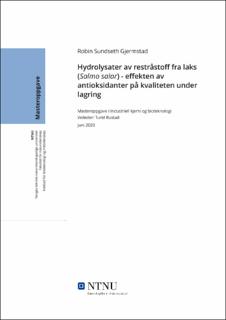| dc.description.abstract | Årlig genererer oppdrett av laks (Salmo salar) og regnbueørret (Oncorhynchus mykiss) i Norge flere hundre tusen tonn restråstoff. Dette restråstoffet inneholder verdifulle omega-3-fettsyrer og lett-fordøyelige proteiner. I Norge går 7% av dette restråstoffet til humant konsum, mens omtrent halvparten går til ensilasje og videre produksjon av fiske- og husdyrfôr. For å øke verdiskapningen er det ønskelig å øke produksjonen av høyverdige produkter til humant konsum. Ved enzymatisk hydrolyse av restråstoffet kan det produseres proteinhydrolysater med bedre funksjonelle, bioaktive og ernæringsmessige egenskaper sammenlignet med de opprinnelige proteinene i råstoffet.
I denne oppgaven ble proteinhydrolysater (PH) produsert ved enzymatisk hydrolyse av kvernede laksehoder (S. salar). Målet var å undersøke hvordan tilsats av ulike antioksidanter påvirker løseligheten, oksidasjonsnivået og fargen til proteinhydrolysatene, og hvordan disse endres under lagring i romtemperatur. I denne studien ble det tilsatt naturlige (askorbinsyre og sitronsyre) eller syntetiske antioksidanter (propylgallat og butylhydroksytoluen (BHT)). Hvis hydrolysater skal anvendes i humant konsum, må de kunne lagres uten at proteinkvaliteten reduseres eller at hydrolysatene misfarges eller oksideres.
Resultatene viste at proteinhydrolysatene hadde et relativt høyt innhold av vannløselige proteiner og de essensielle aminosyrene Ile, Leu, Lys, Thr og Val. Aminosyren Met ble funnet i liten grad, noe som indikerer oksidasjon til metionin sulfoksid. Oksidasjon av Tyr ble observert i alle hydrolysatene, bortsett fra i hydrolysatet tilsatt askorbinsyre. Lagring og tilsats av antioksidanter påvirket hydrolysegraden og sammensetningen av frie og totale aminosyrer i liten grad.
Reduksjon i innhold av tioler ved økende lagringstid i PH tilsatt askorbinsyre, sitronsyre, BHT og kontrollprøven, indikerte oksidasjon av Cys og dannelse av disulfidbindinger. Oksiderte proteinhydrolysater kan selv indusere oksidasjon i matvarer de tilsettes i, noe som kan resultere i uønsket smak og lukt. Tiolinnholdet i PH tilsatt propylgallat var relativt stabilt, og propylgallat var dermed den antioksidanten som beskyttet best mot oksidasjon av Cys.
Propylgallat beskyttet også best mot misfarging. Etter seks måneders lagring fremsto hydrolysatet tilsatt propylgallat som tilnærmet uendret. Dette hydrolysatet hadde også høyest innhold av nitrogen, samt et relativt lavt innhold av frie aminosyrer. Totalt sett kan det konkluderes med at propylgallat var antioksidanten som bevarte hydrolysatene best under lagring. | |
| dc.description.abstract | Annually, farming of Atlantic salmon (Salmo salar) and rainbow trout (Oncorhynchus mykiss) in Norway generates hundreds of thousands of tonnes of rest raw material. This rest raw material contains valuable omega-3 fatty acids and easily digestible protein fractions. In Norway, 7% of this rest raw material goes to human consumption, while about half goes to silage and further production of fish feed and livestock fodder. In order to increase the wealth creation, it is desirable to increase the production of high-quality products for human consumption. By enzymatic hydrolysis of the rest raw material, protein hydrolysates with better functional, bioactive and nutritional properties, compared to the intact proteins in the raw material, can be produced.
In this thesis, protein hydrolysates (PH) were produced by enzymatic hydrolysis of minced salmon heads (S. salar). The aim was to investigate how the addition of different antioxidants influence the solubility, the level of oxidation and the color of the hydrolysates, and how these change during storage at room temperature. In this study, natural (ascorbic acid and citric acid) or synthetic antioxidants (propyl gallate and butylated hydroxytoluene (BHT)) were added. In order to use hydrolysates in human consumption, they must be able to be stored without reducing protein quality. In addition, oxidation and discoloration of the hydrolysates need to be prevented during storage.
The results showed that the protein hydrolysates had a relatively high content of water-soluble proteins and the essential amino acids Ile, Leu, Lys, Thr and Val. The amino acid Met was found in small amounts, indicating oxidation to methionine sulfoxide. Oxidation of Tyr was observed in all the hydrolysates, except from the hydrolysate added ascorbic acid. Storage and addition of antioxidants affected the degree of hydrolysis and the composition of free and total amino acids to a small extent.
Reduction of thiol content, with increased storage time in PH added ascorbic acid, citric acid, BHT and the control sample, indicated oxidation of Cys and formation of disulfide bonds. Oxidized protein hydrolysates can induce oxidation when added in products, which can result in undesirable taste and odor. The thiol content of PH added propyl gallate was relatively stable, and propyl gallate was therefore the most useful antioxidant to protect against oxidation of Cys.
Furthermore, propyl gallate showed the best protection against discoloration. After six months of storage, the hydrolysate added propyl gallate appeared almost unchanged. In addition, this hydrolysate had the highest content of nitrogen, as well as a relatively low content of free amino acids. To conclude, propyl gallate was the antioxidant that best preserved the hydrolysates during storage. | |
